#science birhdays
Photo

Ellen Swallow Richards was born on December 3, 1842. An American industrial and safety engineer, environmental chemist, and university faculty member in the United States during the 19th century. Her pioneering work in sanitary engineering, and experimental research in domestic science, laid a foundation for the new science of home economics. She was the founder of the home economics movement characterized by the application of science to the home, and the first to apply chemistry to the study of nutrition. Richards was the first woman in America accepted to any school of science and technology, and the first American woman to obtain a degree in chemistry, which she earned from Vassar College in 1870.
#ellen swallow richards#chemistry#chemists#home economics#nutrition#women in science#women in history#science#science history#science birhdays#on this day#on this day in science history
53 notes
·
View notes
Photo

Aww.
x
662 notes
·
View notes
Photo

Temple Grandin was born on August 29, 1947. An American scientist, academic, and animal behaviorist. She is a prominent proponent for the humane treatment of livestock for slaughter and the author of more than 60 scientific papers on animal behavior. Grandin is a consultant to the livestock industry, where she offers advice on animal behavior, and is also an autism spokesperson. Grandin is one of the first autistic people to document the insights she gained from her personal experience of autism. In 2010, Time 100—an annual list of the 100 most influential people in the world—named her in the “Heroes” category. She was the subject of the Emmy- and Golden Globe-winning biographical film Temple Grandin. Grandin has been an outspoken proponent of autism rights and neurodiversity.
#temple grandin#autism#autistic#autism rights#neurodiversity#neurospicy#time 100#women in science#women in history#science#science history#science birhdays#on this day#on this day in science history
34 notes
·
View notes
Photo

Émilie du Châtelet was born on December 17, 1706. A French natural philosopher and mathematician, her most recognized achievement is her translation of and commentary on Isaac Newton’s 1687 book Philosophiæ Naturalis Principia Mathematica containing basic laws of physics. The translation, published posthumously in 1756, is still considered the standard French translation. Her commentary includes a contribution to Newtonian mechanics—the postulate of an additional conservation law for total energy, of which kinetic energy of motion is one element. This led to her conceptualization of energy as such, and to derive its quantitative relationships to the mass and velocity of an object.
#emilie du chatelet#physics#isaac newton#energy#kinetic energy#women in science#women in history#science#science history#science birhdays#on this day#on this day in science history
13 notes
·
View notes
Photo
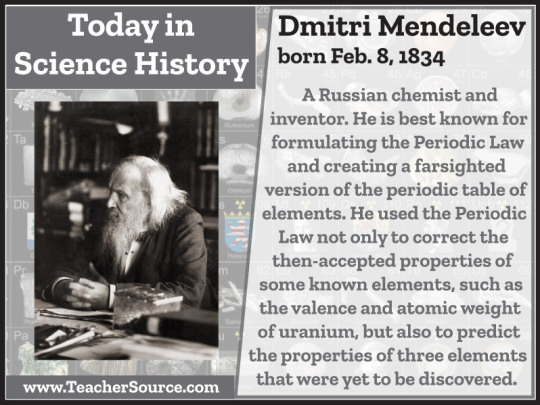
Dmitri Mendeleev was born on February 8, 1834. A Russian chemist and inventor. He is best known for formulating the Periodic Law and creating a farsighted version of the periodic table of elements. He used the Periodic Law not only to correct the then accepted properties of some known elements, such as the valence and atomic weight of uranium, but also to predict the properties of three elements that were yet to be discovered.
#dmitri mendeleev#elements#the periodic table#periodic law#chemistry#chemists#science#science history#science birhdays#on this day#on this day in science history
3 notes
·
View notes
Photo

Alfred Hershey was born on December 4, 1908. An American Nobel Prize–winning bacteriologist and geneticist, he began performing experiments with bacteriophages with Italian-American Salvador Luria, German Max Delbrück, and observed that when two different strains of bacteriophage have infected the same bacteria, the two viruses may exchange genetic information. He and Martha Chase performed the famous Hershey–Chase experiment in 1952, which provided additional evidence that DNA, not protein, was the genetic material of life.
#alfred hershey#genetics#biology#bacteria#bacteriophages#dna#viruses#nobel prize#nobel prize winners#science#science history#science birhdays#on this day#on this day in science history
3 notes
·
View notes
Photo
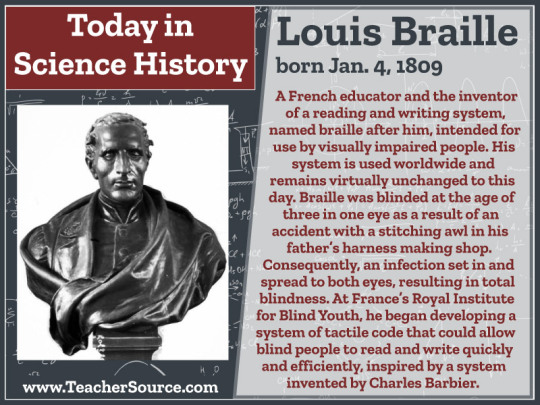
Louis Braille was born on January 4, 1809. A French educator and the inventor of a reading and writing system, named braille after him, intended for use by visually impaired people. His system is used worldwide and remains virtually unchanged to this day. Braille was blinded at the age of three in one eye as a result of an accident with a stitching awl in his father’s harness making shop. Consequently, an infection set in and spread to both eyes, resulting in total blindness. At France’s Royal Institute for Blind Youth, he began developing a system of tactile code that could allow blind people to read and write quickly and efficiently, inspired by a system invented by Charles Barbier.
#louis braille#braille#blindness#visual impairment#inventors#science#science history#science birhdays#on this day#on this day in science history
2 notes
·
View notes
Photo

Theodor Schwann was born on December 7, 1810. A German physician and physiologist, his most significant contribution to biology is considered to be the extension of cell theory to animals. Other contributions include the discovery of Schwann cells in the peripheral nervous system, the discovery and study of pepsin, the discovery of the organic nature of yeast, and the invention of the term “metabolism”. Schwann’s idea of the cell as a fundamental, active unit then can be seen as foundational to the development of microbiology as “a rigorously lawful science”.
#theodor schwann#physiology#biology#cell theory#pepsin#yeast#metabolism#microbiology#science#science history#science birhdays#on this day#on this day in science history
2 notes
·
View notes
Photo
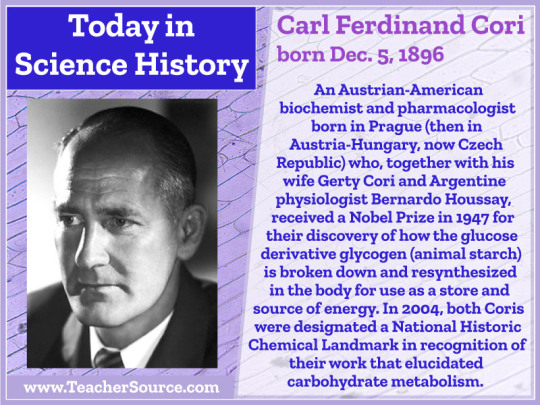
Carl Ferdinand Cori was born on December 5, 1896. An Austrian-American biochemist and pharmacologist born in Prague (then in Austria-Hungary, now Czech Republic) who, together with his wife Gerty Cori and Argentine physiologist Bernardo Houssay, received a Nobel Prize in 1947 for their discovery of how the glucose derivative glycogen (animal starch) is broken down and resynthesized in the body for use as a store and source of energy. In 2004, both Coris were designated a National Historic Chemical Landmark in recognition of their work that elucidated carbohydrate metabolism.
#carl ferdinand cori#biochemistry#pharmacology#glucose#carbohydrates#metabolism#nobel prize#nobel prize winners#science#science birhdays#science history#on this day#on this day in science history
3 notes
·
View notes
Photo

Carl Peter Thunberg was born on November 11, 1743. A Swedish naturalist and an “apostle” of Carl Linnaeus. After studying under Linnaeus at Uppsala University, he spent seven years travelling in southern Africa and Asia, collecting and describing many plants and animals new to European science, and observing local cultures. He has been called “the father of South African botany”. Thunberg’s knowledge exchange led to a cultural opening-up, which manifested itself in the spread of universities and boarding schools which taught knowledge of the other culture and spread medical knowledge as well. For this reason, Thunberg has been called “the most important eye witness of Tokugawa Japan in the eighteenth century”.
#carl peter thunberg#botany#botanists#science#science history#science birhdays#on this day#on this day in science history
2 notes
·
View notes
Photo
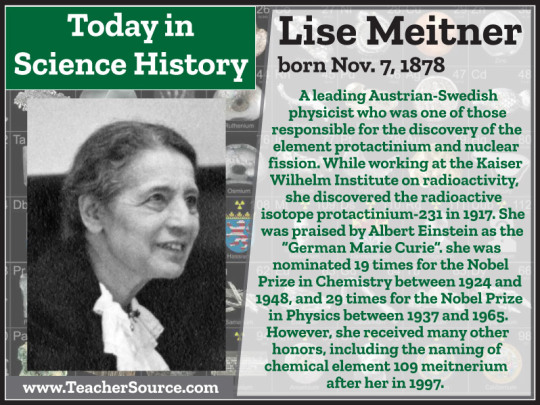
Lise Meitner was born on November 7, 1878. A leading Austrian-Swedish physicist who was one of those responsible for the discovery of the element protactinium and nuclear fission. While working at the Kaiser Wilhelm Institute on radioactivity, she discovered the radioactive isotope protactinium-231 in 1917. She was praised by Albert Einstein as the “German Marie Curie”. she was nominated 19 times for the Nobel Prize in Chemistry between 1924 and 1948, and 29 times for the Nobel Prize in Physics between 1937 and 1965. However, she received many other honors, including the naming of chemical element 109 meitnerium after her in 1997.
#lise meitner#physics#chemistry#radioactivity#german marie curie#meitnerium#women in science#women in history#science#science history#science birhdays#on this day#on this day in science history#fission#nuclear fission
2 notes
·
View notes
Photo
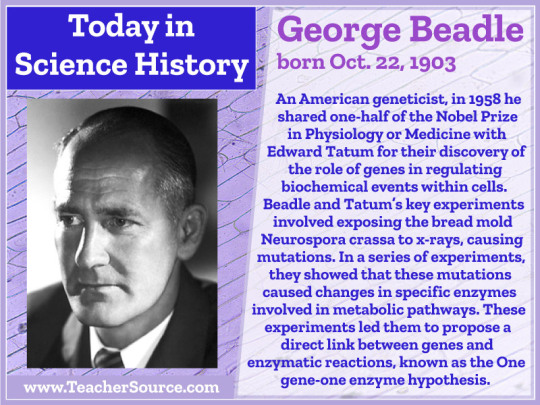
George Beadle was born on October 22, 1903. An American geneticist, in 1958 he shared one-half of the Nobel Prize in Physiology or Medicine with Edward Tatum for their discovery of the role of genes in regulating biochemical events within cells. Beadle and Tatum’s key experiments involved exposing the bread mold Neurospora crassa to x-rays, causing mutations. In a series of experiments, they showed that these mutations caused changes in specific enzymes involved in metabolic pathways. These experiments led them to propose a direct link between genes and enzymatic reactions, known as the One gene-one enzyme hypothesis.
#george beadle#x-rays#genetics#enzymes#mutations#biochemistry#nobel prize#nobel prize winners#science#science birhdays#science history#on this day#on this day in science history
2 notes
·
View notes
Photo

Clara Immerwahr was born on June 21, 1870. A German chemist, she was the first German woman to be awarded a doctorate in chemistry in Germany, and is credited with being a pacifist as well as a women's rights activist. Immerwahr studied at the University of Breslau, attaining her degree and a PhD in chemistry under Richard Abegg in 1900, after 8 semesters of study (two more than required for male doctoral candidates). Her thesis defense was held in the main hall of the university and was attended by many young women of the city, interested in seeing "Unser erster weiblicher Doktor" ("our first female doctor").
#clara immerwahr#chemists#chemistry#women in science#women in history#science#science history#science birhdays#on this day#on this day in science history
4 notes
·
View notes
Photo

Carl Linnaaeus was born on May 23, 1707. A Swedish botanist, zoologist, taxonomist, and physician who formalized binomial nomenclature, the modern system of naming organisms. He is known as the "father of modern taxonomy". In botany and zoology, the abbreviation L. is used to indicate Linnaeus as the authority for a species' name. In older publications, the abbreviation "Linn." is found. Linnaeus's remains constitute the type specimen for the species Homo sapiens following the International Code of Zoological Nomenclature, since the sole specimen that he is known to have examined was himself.
#carl linnaeus#botany#zoology#taxonomy#nomenclature#science#science history#science birhdays#on this day#on this day in science history
2 notes
·
View notes
Photo

Nicéphore Niépce was born on March 7, 1765. A French inventor, usually credited with the invention of photography. Niépce developed heliography, a technique he used to create the world's oldest surviving product of a photographic process: a print made from a photoengraved printing plate in 1825. In 1826 or 1827, he used a primitive camera to produce the oldest surviving photograph of a real-world scene. Among Niépce’s other inventions was the Pyréolophore, one of the world’s first internal combustion engines, which he conceived, created, and developed with his older brother Claude Niépce.
#Nicéphore Niépce#inventors#heliography#photgraphy#science#science birhdays#science history#on this day#on this day in science history
0 notes
Photo

Gerard K. O'Neill was born on February 6, 1927. An American physicist and space activist, as a faculty member of Princeton University, he invented a device called the particle storage ring for high-energy physics experiments. Later, he invented a magnetic launcher called the mass driver. In the 1970s, he developed a plan to build human settlements in outer space, including a space habitat design known as the O’Neill cylinder. He founded the Space Studies Institute, an organization devoted to funding research into space manufacturing and colonization. His award-winning book The High Frontier: Human Colonies in Space inspired a generation of space exploration advocates.
#gerard k. o'neill#physics#space#particle storage#o'neill cylinder#space studies institute#home science#science birhdays#science history#on this day#on this day in science history
1 note
·
View note